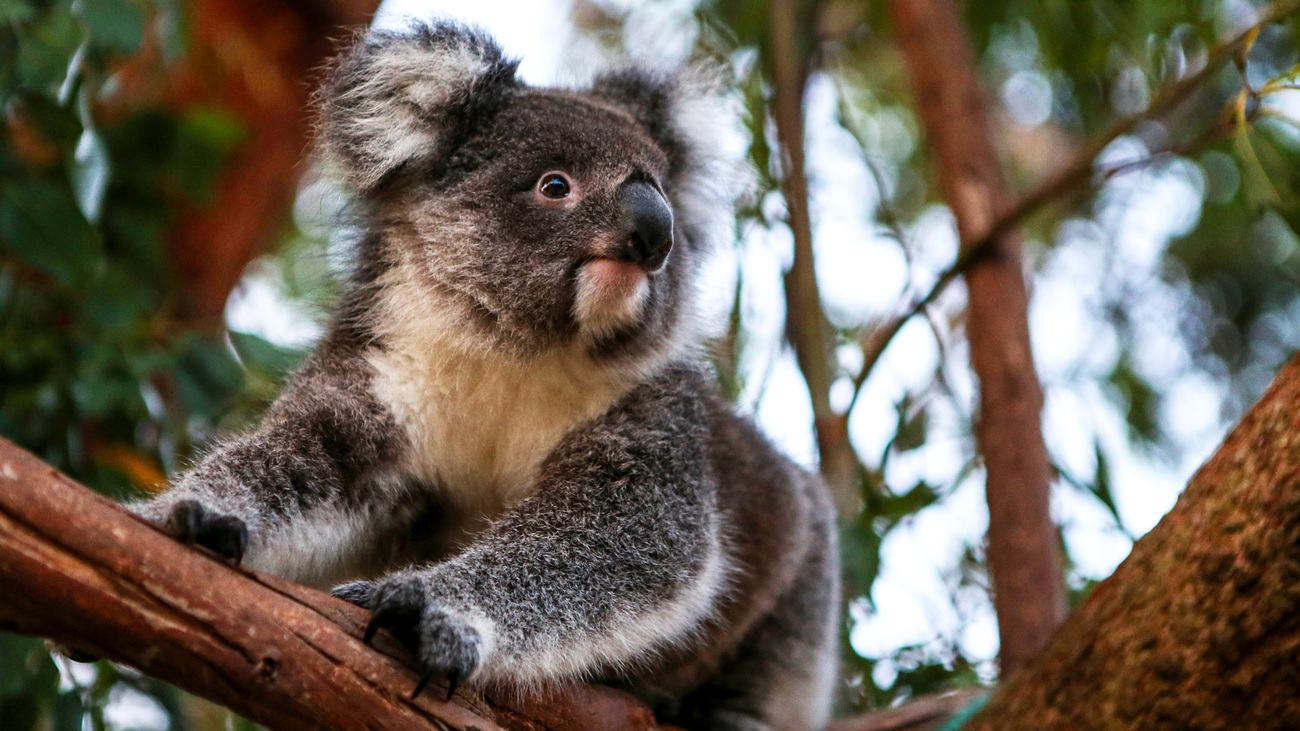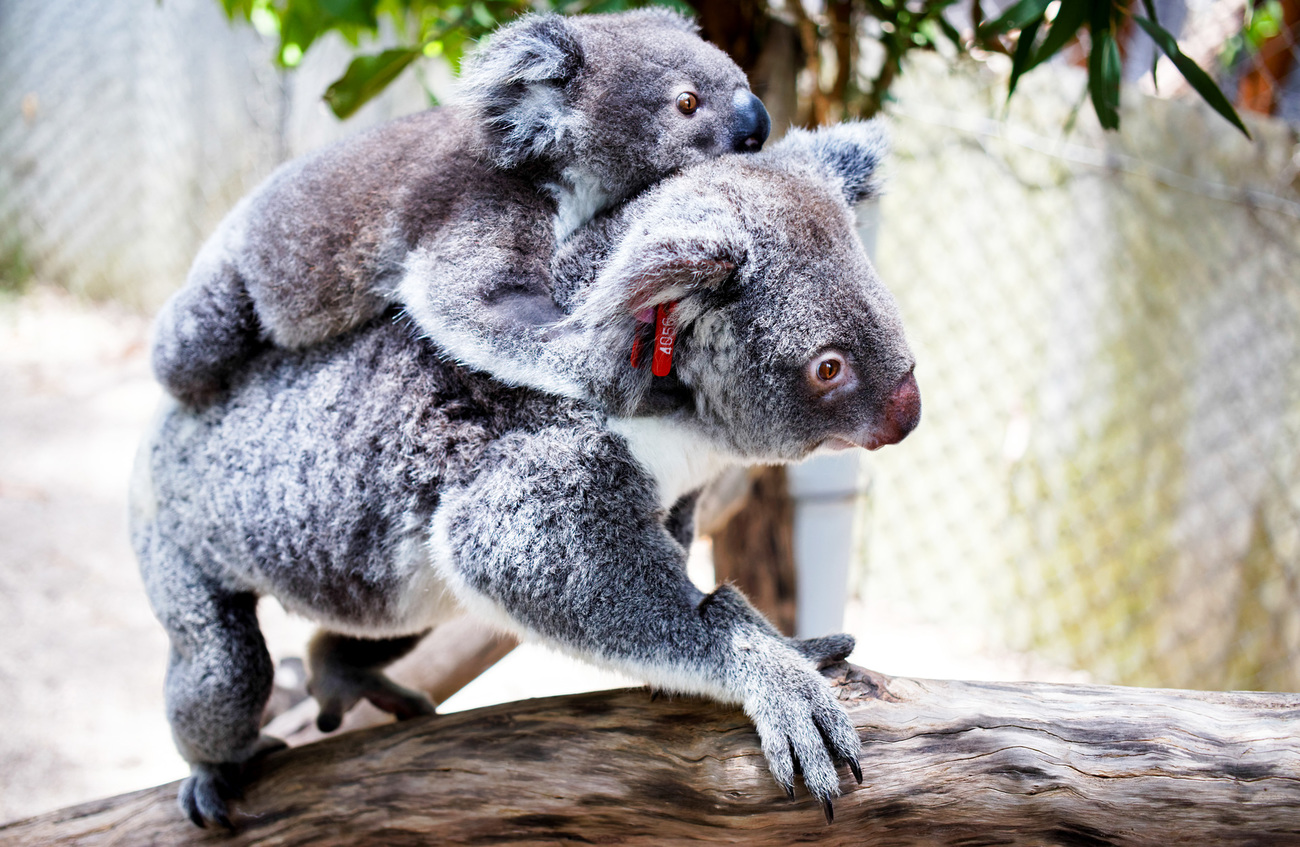Rescuing animals during bushfires - Australia
For over 30 years we’ve been on the ground helping animals affected by bushfiresKoalas—the grey, furry animals from Australia that carry their joeys in pouches—are some of the most beloved animals on the planet. They attract tourists to the continent by the masses and are of vital importance to their ecosystems. Sadly, though, they are in danger of extinction.
Read on to learn a few things that may surprise you about koalas. Clear up the misconception that koalas are not bears, see how many koalas are left in the wild, and find out what you should do if you see a sick or injured koala.

1. Are koalas bears?
Despite the widespread colloquial use of the term ‘koala bears’, koalas are not actually bears—they are marsupials. European settlers that arrived in Australia inaccurately called koalas ‘bears’ because of their resemblance to bears. Their scientific name, Phascolarctos cinereus, actually means ‘pouched bear’.
Koalas are not members of the bear family, Ursidae; rather, they are the only members of the family Phascolarctidae.
2. Do koalas have pouches?
Koalas are marsupials, which means yes, they have pouches. Unlike kangaroo pouches, which have an opening at the top, koala pouches have a more centrally located opening, which the mother keeps closed using a strong sphincter muscle. The pouch protects young koalas, called joeys, from injury while the mother climbs among trees.
3. How long do koalas live?
On average, koalas can live for 10 to 12 years in the wild. However, few koalas, especially males, survive beyond 10 years, due to disease, vehicle collisions, habitat loss and predation by dogs and other animals. Females can live up to 18 years and continue breeding in their older years.
4. How many koalas are there in the wild in 2024?
Currently, the IUCN estimates that there are between 100,000 and 500,000 koalas. It’s difficult to determine precise numbers. Because koalas are so difficult to spot in the wild and are distributed across such large areas, there is no consistent mapping or monitoring method.
What we do know is that there used to be millions of koalas in Australia, but now, in some areas, you are lucky to see even one in the wild. Their numbers are plummeting in Queensland and New South Wales, and while they are considered more abundant in other areas, they face a multitude of threats. Koalas are in trouble and need all the help they can get.
5. Are koalas friendly? Are koalas mean?
Despite their cute and cuddly appearance, koalas are wild animals that can become aggressive. Koalas have sharp claws and teeth. They can easily cause injury to a human if they feel threatened or stressed and lash out.
Like all wild animals, koalas shouldn’t be approached unless they’re injured, sitting or lying on the ground for an extended period of time, or otherwise in need of help. If you see a koala in the wild that appears injured or sick, contact your local wildlife authorities to report the situation.
6. How many joeys are born at a time?
Koala mothers usually have one joey per year and on rare occasions give birth to twins. The breeding season is generally between September and February. However, in some years, it can be extended by up to six weeks due to an increased availability of food and changes in the weather.

7. How long do koala joeys stay in their mothers’ pouches?
Koala joeys usually stay in their mothers’ pouches for about six months. After this, they will ride on their mothers’ backs and remain there until they are almost one year old, at which point they can live more independently.
8. How long is a koala’s gestation period?
Female koalas are pregnant for only about 35 days, a relatively short gestation period when compared to all mammals, but average when compared to just marsupials. Their gestation period doesn’t need to be as long because once the joey emerges, the mother koala continues to carry it with her in her pouch.
9. What do koala joeys eat?
Koala joeys cannot regulate their own body temperatures at first, so they rely on their mothers for warmth and milk. Mothers have two teats or nipples in the pouch, which allow young koalas to feed on milk produced by glands in the mother’s abdomen. At about six months, joeys pop their head outside the pouch to feed on ‘pap’, a substance the mother produces in addition to milk that allows the joey to prepare its stomach for a transition from milk to eucalyptus leaves.
10. How much do koalas weigh?
Adult koalas generally weigh about three to 12 kilograms (six to 26 pounds). The average size and weight of koalas varies by region—adult female koalas in Queensland weigh five to six kilograms on average, and adult males in Queensland weigh six to eight kilograms. In comparison, adult female koalas from Victoria weigh 8.5 kilograms on average, and adult males weigh 12 kilograms.
When they are born, koala joeys weigh about one gram (0.035 oz) and grow rapidly during their time in the pouch due to a high-protein diet of milk that is produced by specialised glands inside the mother’s body. Koala joeys can increase up to 10 times their initial size within three months! By six months old, baby koalas have reached their adult weights.
11. What do koalas look like?
Koalas are medium-sized marsupials with large, round heads, mostly grey fur, fluffy ears with some white fur, and large, black noses. They also have some white fur on their chests, inner arms, and bottoms. On their noses and the palms of their paws, koalas have no fur.
Though they look fluffy and fuzzy, koalas’ fur is more coarse, like sheep’s wool. Their fur colour varies from grey to light brown, and it can depend on the koala’s region. Queensland koalas appear lighter in colour and have less fur than those in New South Wales, Victoria, and South Australia.
Koalas have long, sharp claws, which make them well suited for climbing trees. They also have opposable thumbs, giving them a good grip.
Adult male koalas are generally larger than adult female koalas. Males have much larger heads and noses than females, and they have large scent glands in the middle of their chests that appear pink.
12. How long does it take for koala joeys to develop the skills needed for independent living?
Koala joeys stay with their mothers until they are almost one year old, developing important life skills such as climbing trees and finding food before venturing out on their own. This means that female koalas usually only produce one joey each year due to having little opportunity to breed while caring for their young.
13. Are koalas endangered?
Populations of some species have declined dramatically over the last century or so due to habitat loss, disease and dog attacks. The IUCN lists the koala as vulnerable on its Red List of Threatened Species.
Koalas are listed as endangered in Queensland, New South Wales, and the Australian Capital Territory under Australian national environmental laws (Environmental Protection and Biodiversity Act 1999).
14. What are threats to koalas?
Habitat destruction caused by excessive land clearing and development is the biggest threat to koalas as it forces them to live in urban areas where they face deadly encounters with cars and domestic dogs. Sadly, humans and koalas like to live in the same places: lush, sub-tropical, coastal areas. Australia has one of the world’s worst deforestation rates—NSW is on a par with Brazil.
15. What is being done to help koalas?
It is crucial that koalas have a safe and secure habitat to increase their chances of survival. We have been working hard to rebuild vital wildlife corridors to give koalas and other native species the safe refuges they desperately need. Through our partnership with Friends of the Koala and Mosswood Wildlife, IFAW works to rescue, rehabilitate, and release injured or orphaned koalas—giving them a second chance at life in the wild. We’ve invested in a groundbreaking research project with our partners at the University of the Sunshine Coast, whose Detection Dogs for Conservation team collects data about the genetics and health of koala populations so we can understand the resilience of koalas after bushfires.
We also work with partners like Koala Clancy Foundation and Bangalow Koalas to restore koala habitats by planting trees, providing access to more food sources, and reconnecting fragmented populations. We have also embarked on a new project—Koala Climate Corridors—with the Great Eastern Ranges to create biodiverse climate corridors to help koalas, as a flagship species, adapt to the impacts of climate change.
To create real change, we need to work with the government, so we continue to advocate for stronger environmental laws to protect our native wildlife and the places they call home.
16. What can you do to help?
Every one of us has a part to play in securing a future for koalas and the places they call home. Individuals can make a tangible impact by planting trees themselves.
If you want to help us call on the Australian government to strengthen our national environment laws to protect wildlife like koalas and the places they call home, you can sign our petition.
Share your support of IFAW on Facebook, Instagram, Twitter, or TikTok.
If you’re in Australia, you can download the free IFAW Wildlife Rescue App to help report injured or distressed wildlife and contact the appropriate teams to rescue them.
Related content
every problem has a solution, every solution needs support.
The problems we face are urgent, complicated, and resistant to change. Real solutions demand creativity, hard work, and involvement from people like you.